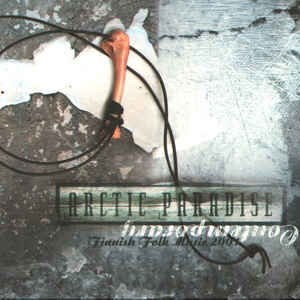 Judith Gennett penned this review.
Judith Gennett penned this review.
Finland, with only 5 1/2 million people, is home to Linux, Nokia, and a lot of amazing music. Arctic Paradise is a free promotional sampler series devised by the Finnish Music Information Center to introduce the Finnish folk music that’s currently amazing the rest of the world. Included with the CD is a 36-page booklet.
The CD has culled the best of “contemporary” Finnish folk music. Some artists, like Varttina and Wimme, are fairly well known, but others will be familiar only to Nordophiles. Interestingly, only five of the tracks are traditional music, the rest for the most part are composed in a traditional style and many are transposed and fused freely. Two of the tracks are from the Swedish minority: Gjallarhorn’s opening “Dejellil och Lagerman,” infused with digeridoo, and Ramunder’s instrumental “Andersson och Holmstrom” featuring the accordion of Maria Kalaniemi), both from traditional sources. Wimme and the band Vilddas contribute a little Saami ethno-fusion. The rest is to a greater or lesser extent tinkering with the Finnish tradition. Me Naiset sheds a more down-to-earth style to sound like a professional choir in the traditional “Mielli miehelle.” JPP fiddler Arto Jarvela plays the traditional “Tallaae Gee” like the professional he is. Maija Karhinen sings a raucous version of the traditional song, “Lemmen kaki.” Mr. Malaska (a fiddle-accordion duo) compose a new folk tune with strong classical influences, sort of like Yo Yo Ma in Appalachia. Varttinasta Markku Lepisto and wildman Kimmo Pohjonen play accordion compositions which utilize folk music but travel much further, as does Virpi Forsberg and Arja Kastinen’s lovely but odd improvisational work for kantele and goats horn. Kantele player Hannu Saha and mandolinist/accordionist Petri Hakala and Markku Lepisto play their own acoustic folk-influenced but progressive compositions. And, farthest flung, Slobo Horo does Balkan rock.
FMIC uses the most startling track from Varttina’s “Ilmatar” with Ismo Alanko on vocals as a spell caster, and the prettiest, best track on Prusikoukou’s album, fiddler Ville Kangas’ “Goblin,” to illustrate their folk-progressive rock fusion. They also use one of Varttina bassist Pekka Lehti’s best tracks, done with Timo Alakotila, from Lehti’s album “Outo Vihma/Strange Force.” It’s very clear FMIC is out to snag adherents with Finnish glitter.
My favorite track is actually homey rock with folk in it, by Pohjannaula. It’s a fantastic opportunity to hear the words of Finnish…”Kirjanpainaja” (“book in print”) just drips with words used to convey a message instead of as an instrument. Unfortunately I can’t catch them all, so it would be great to have them in print somewhere. (One of my great discoveries was that even Finnish names mean something; “Kalaniemi” means “Cape of the Fish,” but that is another story.)
The booklet may be more informative than the CD itself. In it are photographs, paragraph long descriptions and discographies of 55 folk artists, listings of historical recordings and compilations, as well as contact info and label discographies. This is a great resource if you’re browsing kantele players or staring at a CD for sale or at concert listings. Unfortunately the discographies are now a couple years behind, and Varttina’s line-up keeps changing, but it’s still a great place to spot artists without having to navigate graphics-heavy home pages with a 56K modem.
“All this merely scratches the surface…” the booklet tells us. What’s missing? Traditional music, for one thing. My guess is that the book and recording present the progressive artistic tier of Finnish folk music. What exactly is folk music in Finland? I don’t know, but what you won’t find in this collection also includes common tango and humppa bands on one hand, the kahvia ja pulla of Finnish music, and on the other accordion metal like Finntroll or Moonsorrow. Logical boundaries do exist for the FIMIC.
Who is eligible to get this album from the Finnish Music Information Service? I honestly don’t know, but it’s worth a try to ask. I remember seeing copies of the earlier release used, so maybe it’s more practical to pick one up that way and save the Finlanders the postage.
(Finnish Music Information Center, 2000)
